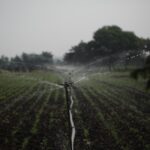Techniques to improve water cycle efficiency in California: Parts of the Sierra Nevada Range and adjacent desert areas experience water shortages.
Techniques to improve water cycle efficiency, Technological Innovations in Water Management, etc
The Great Basin: Thirsty and Facing Challenges
The Great Basin faces a major water shortage. How can we ensure everyone has enough water?
Water Conservation:
- At Home: What are some simple ways to reduce water usage in our homes? (e.g., shorter showers, fixing leaks, watering lawns less often)
- The Water Cycle: Explain the role of evaporation in the Great Basin’s water cycle.
The Active Climate Rescue Initiative:
- Climate Change Impact: How is climate change affecting water supplies in the Great Basin?
- Solutions: What are some solutions the Active Climate Rescue Initiative is working on to address water shortages?
The Consequences of Water Scarcity:
- Impact on Ecosystems: What are the potential impacts of drought on plants, animals, and the overall health of the Great Basin ecosystem?
Moving Forward:
- Sustainable Solutions: What are some smart ways to use water and protect the environment in the Great Basin?
💦 The Great Basin: A Thirsty Land
TL;DR: The Great Basin is a big, dry area with a unique water cycle. Climate change is messing things up, making it even drier. We need to find smart ways to use water and protect the environment to keep the Great Basin healthy.
The Water’s Journey
The Great Basin, a vast region in the western United States, is known for its dry climate. Think mountains, deserts, and salty lakes! The Great Basin includes parts of California, especially the Sierra Nevada mountains and nearby deserts. Water is vital to life in this area, but it doesn’t fall from the sky very often.
Here’s how the water cycle works in the Great Basin:
- Evaporation: The sun heats up water in lakes, rivers, and the ground, turning it into vapor that floats up into the air.
- Condensation: As the vapor rises, it cools and changes back into tiny water droplets, forming clouds.
- Precipitation: When the clouds get full of water droplets, they release rain or snow, mostly in the mountains.
- Runoff: Snow melts and rain flows down the mountains, filling rivers and streams. Some water soaks into the ground, becoming groundwater.
- Storage: Water is stored in lakes, rivers, and underground aquifers (layers of rock that hold water).
- Evaporation: The cycle starts again, as water evaporates back into the air.
A Thirsty Land: Water Shortages
The Great Basin’s water cycle is a delicate dance. However, humans use a lot of water for drinking, farming, and industry. This means there is less water for nature, and sometimes there isn’t enough for everyone.
Here are some of the problems caused by water shortages:
- Less Water for Plants and Animals: Drought can kill trees, hurt wildlife, and make it hard for plants to grow.
- Drying Up Lakes and Rivers: As water levels drop, lakes and rivers shrink, which can harm the fish and other animals that live there.
- Conflicts Over Water: People might argue about who gets to use the limited water, especially farmers, cities, and industries.
Climate Change: Making Things Worse
Climate change is changing the water cycle, making it even drier in the Great Basin.
- Less Snowfall: Warmer temperatures mean less snow in the mountains. Less snow means less water flowing into rivers and streams during the spring and summer months.
- More Evaporation: Hotter temperatures cause more water to evaporate from lakes and rivers, leaving less water for people and nature.
- More Droughts: Climate change is making droughts longer and more severe, leading to more severe water shortages.
Solutions for a Thirsty Land
The Great Basin faces a big challenge, but there are things we can do to make sure there is enough water for everyone:
H2 Water Conservation Practices
- Use Less Water at Home: Take shorter showers, fix leaky faucets, and water your lawn less often.
- Smart Irrigation: Use technology like drip irrigation, which delivers water directly to plant roots, to reduce waste.
- Water-Wise Landscaping: Plant drought-tolerant plants that need less water.
H2 Technological Innovations in Water Management
- Desalination: Turning salty ocean water into fresh drinking water. This can be expensive, but it can help supplement water supplies.
- Groundwater Recharge: Adding water to underground aquifers to store it for later use.
- Improving Water Infrastructure: Fixing leaky pipes and building better water storage systems to reduce waste.
H2 Policy Measures
- Water Conservation Laws: Governments can pass laws to encourage people to use less water.
- Water Rights: Setting up fair systems to make sure everyone has access to water.
- Investing in Research: Supporting research to find new ways to manage water resources.
The Active Climate Rescue Initiative
The Active Climate Rescue Initiative is a group that is working hard to find solutions to climate change and its effects on water supplies. They are dedicated to protecting our planet and finding sustainable ways to use water. You can learn more about them and their work on their website.
Summary
The Great Basin is a dry region facing a water shortage crisis. Climate change is worsening the situation by reducing snowfall, increasing evaporation, and making droughts more severe. There are solutions to this challenge, including water conservation practices, innovative irrigation techniques, and policy measures. The Active Climate Rescue Initiative is working to address these challenges and find sustainable solutions to protect the Great Basin’s water resources. We all have a role to play in finding ways to protect our water resources, which are essential for our future.
More on Techniques to improve water cycle efficiency…
- ## SEO Keywords Related to Water Cycle Efficiency and Technological Innovations in Water Management:
- General Keywords:
- Water cycle efficiency
- Water management technology
- Sustainable water management
- Water conservation techniques
- Water technology innovations
- Efficient water use
- Water resource management
- Water scarcity solutions
- Water security
- Climate change and water
- Drought mitigation
- Specific Techniques and Innovations:
- Rainwater harvesting
- Greywater recycling
- Water-efficient irrigation
- Smart water meters
- Water leak detection
- Water treatment technologies
- Desalination
- Wastewater reuse
- Water-efficient appliances
- Green infrastructure
- Water-sensitive urban design
- Climate-resilient water management
- Integrated water resource management
- Water footprint reduction
- Water auditing
- Water pricing policies
- Water governance
- Water education
- Water conservation awareness
- Technology-Specific Keywords:
- Artificial intelligence in water management
- Internet of Things (IoT) for water
- Smart water grids
- Sensor-based water monitoring
- Remote sensing for water management
- Drones for water management
- Big data analytics for water
- Blockchain for water
- 3D printing in water infrastructure
- Nanotechnology for water treatment
- Biomimicry in water engineering
- Regional/Industry-Specific Keywords:
- Water management in [specific region]
- Water challenges in [specific industry]
- Water technology for [specific application]
- [Specific water technology] for [specific sector]
- Long-Tail Keywords:
- How to improve water cycle efficiency in your home
- Best water management practices for businesses
- Innovative water technology solutions for agriculture
- Water conservation tips for homeowners
- The future of water management
- Investing in water technology
- Note:** This list is not exhaustive, and it’s recommended to use keyword research tools to identify the most relevant keywords for your specific content and target audience.




